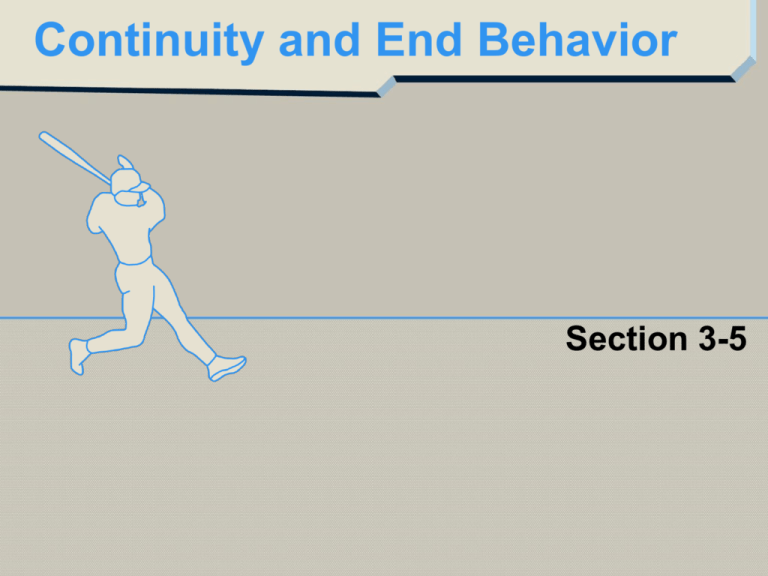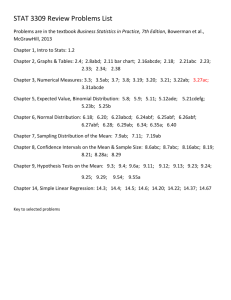3-5 Continuity and End Behavior
advertisement

Continuity and End Behavior Section 3-5 Learning Target • I can determine whether a function is continuous or discontinuous • I can identify the end behavior of functions • I can determine whether a function is increasing or decreasing on an interval Continuous Function-the graph of this function is smooth or continuous curves. (Linear and Quadratic Function) Discontinuous function- the graph of this function cannot be trace without lifting your pencil (step wise and absolute value). The chart below shows the different types of discontinuous functions. Function 1 y 2 x Name Infinite Discontinuity Graph Characteristics The graph becomes greater and greater as it approaches a given x-value. Function Name Graph Characteristics The graph stops at a given value of the domain and then begins again at a different range value for the same value of the domain. x 1 f ( x) x 1 2 Jump Discontinuity x 2 1 if x 0 f ( x) if x 0 x Point Discontinuity When there is a value in the domain for which the function is undefined, but the pieces of the graph match up. There is a hole in the graph. Continuity Test A function is continuous at x = c if it satisfies the following conditions: 1. the function is defined at c; or f(c) exists 2. the function approaches the same yvalue on the left and right sides of x = c 3. the y-value that the function approaches from each side is f(c). Example: Determine whether the function is continuous at the given x-value. x2 4 f ( x) ; x 2 x2 Determine whether each function is continuous at the given x-value. a. f(x) = x3 + 2x - 1; x = 2 x2 + 5x + 6 b. f(x) = ; x = -3 x+3 c. x2 if x 0 f ( x) = ;x 0 x 2 if x 0 Another tool that is used for analyzing functions is end behavior. End behavior is just a way to describe what happens to the graph at the ends. In the table below “leading coefficient” refers to the coefficient in the term of the polynomial with the highest power of x. For instance, 3 is the leading coefficient in the polynomial f ( x ) 3x 4 2 x 3 4 x 7 . Polynomial Properties End Behavior Leading coefficient is positive; highest power is even As x gets very large, y gets very large; as x gets very small, y gets very large. Example f ( x ) 3x 2 f ( x ) as x f ( x ) as x f ( x ) 3x 2 f ( x ) as x f ( x ) as x Leading coefficient is negative; highest power is even As x gets very large, y gets very small; as x gets very small, y gets very small. Polynomial Properties End Behavior Example f ( x) 2 x3 f ( x ) as x f ( x ) as x Leading coefficient is positive; highest power is odd As x gets very large, y gets very large; as x gets very small, y gets very small. f ( x ) 2 x 3 f ( x ) as x f ( x ) as x Leading coefficient is negative; highest power is odd As x gets very large, y gets very small; as x gets very small, y gets very large. Another characteristic of functions used for analysis is the monotonicity of the function. This means that on an interval, the function is increasing or decreasing on that particular interval. Whether a graph is increasing or decreasing is always judged by viewing a graph from left to right. Function Increasing Decreasing Constant Characteristics A function f is increasing on an interval if and only if for every a and b contained in the interval, f(a)<f(b) whenever a<b A function f is increasing on an interval if and only if for every a and b contained in the interval, f(a)>f(b) whenever a<b A function f is increasing on an interval if and only if for every a and b contained in the interval, f(a)=f(b) whenever a<b Example: Describe the end behavior of the function. Graph the function and determine the intervals on which the function is increasing and the intervals on which the function is decreasing. f ( x ) 5x 3 x 2 x 4 The leading coefficient is positive and the highest power is odd. Therefore, as x , y and as x , y . Use your graphing calculator to find the relative max and relative min to find your boundaries for the increasing and decreasing intervals. Describe the end behavior of f(x) = 3x2 + 4x + 1 and g(x) = -2x2 + 2x. Use your calculator to create a table of function values so you can investigate the end behavior of the y-values. f(x) = 3x2 + 4x + 1 f(x) x -10,000 299,960,001 -1000 2,996,001 -100 29,601 -10 261 0 1 10 341 100 30,401 1000 3,004,001 10,000 300,040,001 g(x) = -2x2 + 2x g(x) x -10,000 -200,020,000 -1000 -2,002,000 -100 -20,200 -10 -220 0 0 10 -180 100 -19,800 1000 -1,998,000 10,000 -199,980,000 Notice that both polynomial functions have y-values that become very large in absolute value as x gets very large in absolute value. The end behavior of f(x) can be summarized by stating that as x , f(x) and as x -, f(x) . The end behavior of g(x) can be summarized by stating that as x , g(x) - and as x - , g(x) -. You may wish to graph these functions on a graphing calculator to verify this summary. Graph each function. Determine the interval(s) on which the function is increasing and the interval(s) on which the function is decreasing. a. f(x) = (x + 1)2 - 4 The graph of this function is obtained by transforming the parent graph p(x) = x2. The parent graph has been translated 1 unit to the left, and translated down 4 units. The function is decreasing for x < -1 and increasing for x > -1. At x = -1, there is a critical point. b. f(x) = |x - 3| + 2 The graph of this function is obtained by transforming the parent graph p(x) = |x|. The parent graph has been reflected about the x-axis, translated 3 units right, and translated up two units. This function is increasing for x < 3 and decreasing for x > 3. There is a critical point when x = 3. c. f(x) = -x3 - x2 + x + 2 This function has more than one critical point. It changes direction at 1 x = -1 and x = 3. The function is decreasing for x < -1. The function is 1 also decreasing for x > . When 3 1 -1 < x < 3, the function is increasing. Helpful Websites Discontinuity: http://www.sparknotes.com/math/precalc/continuityandlimits/prob lems3.rhtml http://math.usask.ca/~maclean/101/Limits/Printables/BW/Continuit y.pdf End behavior: http://www.purplemath.com/modules/polyends.htm 3-5 Self Check Quiz: http://www.glencoe.com/sec/math/studytools/cgibin/msgQuiz.php4?isbn=0-07-8608619&chapter=3&lesson=5&quizType=1&headerFile=4&state=







